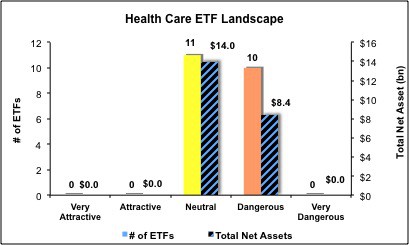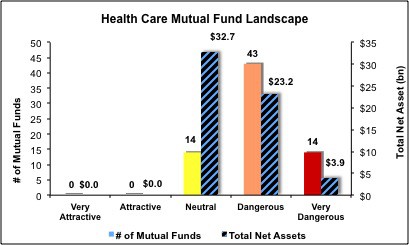The Health Care sector ranks sixth out of the ten sectors as detailed in my Sector Rankings for ETFs and Mutual Funds report. It gets my Dangerous rating, which is based on aggregation of ratings of 21 ETFs and 71 mutual funds in the Health Care sector as of October 4, 2013. Prior reports on the best & worst ETFs and mutual funds in every sector are here.
Figures 1 and 2 show the five best and worst-rated ETFs and mutual funds in the sector. Not all Health Care sector ETFs and mutual funds are created the same. The number of holdings varies widely (from 20 to 291), which creates drastically different investment implications and ratings. The best ETFs and mutual funds allocate more value to Attractive-or-better-rated stocks than the worst ETFs and mutual funds, which allocate too much value to Neutral-or-worse-rated stocks.
To identify the best and avoid the worst ETFs and mutual funds within the Health Care sector, investors need a predictive rating based on (1) stocks ratings of the holdings and (2) the all-in expenses of each ETF and mutual fund. Investors need not rely on backward-looking ratings. My fund rating methodology is detailed here.
Investors should not buy any Health Care ETFs or mutual funds because none get an Attractive-or-better rating. If you must have exposure to this sector, you should buy a basket of Attractive-or-better rated stocks and avoid paying undeserved fund fees. Active management has a long history of not paying off. Here’s the list of my top-rated Health Care sector stocks.
Get my ratings on all ETFs and mutual funds in this sector on my free mutual fund and ETF screener.
Figure 1: ETFs with the Best & Worst Ratings – Top 5
 * Best ETFs exclude ETFs with TNAs less than $100 million for inadequate liquidity.
* Best ETFs exclude ETFs with TNAs less than $100 million for inadequate liquidity.
Sources: New Constructs, LLC and company filings
ProShares Ultra Health Care (RXL) is excluded from Figure 1 because its total net assets (TNA) are below $100 million and do not meet our liquidity minimums.
Figure 2: Mutual Funds with the Best & Worst Ratings – Top 5
 * Best mutual funds exclude funds with TNAs less than $100 million for inadequate liquidity.
* Best mutual funds exclude funds with TNAs less than $100 million for inadequate liquidity.
Sources: New Constructs, LLC and company filings
Seven funds are excluded from Figure 2 because their total net assets (TNA) are below $100 million and do not meet our liquidity minimums.
State Street Health Care Select Sector SPDR (XLV) is my top-rated Health Care ETF and Delaware Group Healthcare Fund (DLHIX) is my top-rated Health Care mutual fund. Both earn my Neutral rating.
State Street SPDR S&P Biotech ETF (XBI) is my worst-rated Health Care ETF and Rydex Series Biotechnology Fund (RYBOX) is my worst-rated Health Care mutual fund. XBI earns my Dangerous rating, while RYBOX gets my Very Dangerous rating.
Figure 3 shows that 43 out of the 325 stocks (over 22% of the market value) in Health Care ETFs and mutual funds get an Attractive-or-better rating. However, zero out of 21 Health Care ETFs and zero out of 71 Health Care mutual funds get an Attractive-or-better rating.
The takeaways are: mutual fund managers allocate too much capital to low-quality stocks and Health Care ETFs hold poor quality stocks.
Figure 3: Health Care Sector Landscape For ETFs, Mutual Funds & Stocks
As detailed in “Cheap Funds Dupe Investors”, the fund industry offers many cheap funds but very few funds with high-quality stocks, or with what I call good portfolio management.
Investors need to tread carefully when considering Health Care ETFs and mutual funds, as none of them hold enough good stocks to be considered attractive. In fact, the majority of Health Care ETFs and Mutual Funds earn a Dangerous or worse rating. Investors would be better off focusing on individual Health Care stocks instead.
Amgen Inc. (AMGN) is one of my favorite stocks held by Health Care ETFs and mutual funds and earns my Very Attractive rating. Amgen has grown operating profit (NOPAT) by 18% compounded annually since 2001. Even more encouraging is Amgen’s return on invested capital (ROIC) of 18%, which puts it in the top quintile of all companies I cover. AMGN has also earned positive economic earnings every year since the beginning of my model. Despite this track record, AMGN’s stock price of ~$113 gives it a price to economic book value ratio (PEBV) of 1.0, which means that the market expects AMGN’s profits to never grow from their current level. These expectations seem low for a company with the NOPAT performance of AMGN over the past 12 years. Investors should consider adding AMGN to their portfolio before the market readjusts its outlook.
Vertex Pharmaceuticals (VRTX) is one of my least favorite stocks held by Health Care ETFs and mutual funds and earns my Dangerous rating. VRTX, which has only turned an operating profit (NOPAT) twice since 1998, has a return on invested capital (ROIC) of 4%, a number that puts it in the bottom quintile of all companies I cover. Vertex has also earned negative economic earnings every year since the beginning of my model. Although VRTX has failed to show meaningful growth for investors, the stock still trades at very expensive valuation. To justify the current price (~$78/share), VRTX would need to grow profits by 18% compounded annually for the next 18 years. There is too much risk at this price, and VRTX is trading too high for investors to consider purchasing the stock.
375 stocks of the 3000+ I cover are classified as Health Care stocks.
Figures 4 and 5 show the rating landscape of all Health Care ETFs and mutual funds.
My Sector Rankings for ETFs and Mutual Funds report ranks all sectors and highlights those that offer the best investments.
Figure 4: Separating the Best ETFs From the Worst ETFs
Figure 5: Separating the Best Mutual Funds From the Worst Mutual Funds
Review my full list of ratings and rankings along with reports on all 21 ETFs and 71 mutual funds in the Health Care sector.
André Rouillard contributed to this report.
Disclosure: David Trainer and André Rouillard receive no compensation to write about any specific stock, sector or theme.



